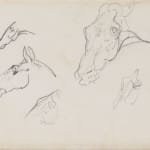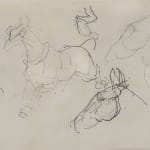Henri de TOULOUSE-LAUTREC
Publications
M. Joyant, Henri de Toulouse-Lautrec, Paris, 1927, vol. II, p.18.
M.G. Dortu, Toulouse-Lautrec et son Oeuvre, vol. IV, New York, 1971,
n. D. 1.703 (recto) and D. 1.704 (verso), p. 281.
Animalia, Galleria Paolo Antonacci Rome, May 2023, entry n. 17.
Henri de Toulouse-Lautrec was born in Albi, in southern France, on 24 November 1864, into one of the country’s most prestigious families. His parents’ marriage was, however, a case of consanguinity (they were cousins) and this was to have a serious impact on their son’s genetic makeup.
In 1872 Henri followed his mother to Paris, where he attended the Lycée Fontanes (now the Lycée Condorcet), yet his already fragile health began to deteriorate when he was ten and it was discovered that he suffered from congenital bone defomation. His legs ceased to grow, so even though he was not a dwarf in the true sense of the term, as an adult he was only 1.52 mt. tall. In this period, he produced a series of small pictures displaying a free and firm hand, the subject matter in the pictures reflecting the equestrian world. The critic Matthias Arnold famously said that “even if he couldn’t ride horses, he wanted at least to be able to paint them!” He then joined the atelier of Fernand Cormon, where he came into contact with Emile Bernard, Eugène Lomont, Albert Grenier, Louis Anquetin and Vincent van Gogh. In January 1884, he left Cormon’s atelier and set up on his own in Montmartre, assiduously frequenting such venues as the Moulin de la Galette and the Moulin Rouge.
These were very proficuous years also from an artistic standpoint. The poster that he produced for the Moulin Rouge in 1891 was a spectacular success, making both him and the Moulin Rouge famous almost overnight.
He showed his work at numerous exhibitions and art fairs throughout Europe and even organised his own on occasion. Stimulated by his initial success, he regularly showed at the Salon des Indèpendants from 1889 to 1894, while also travelling frequently to Brussels and to Spain. The city that dazzled him the most, however, was London.
His constitution was undermined before he reached the age of thirty by the syphilis that he had contracted in the brothels of Paris, which had become his second home. His addiction to alcohol had gained the upper hand by 1897, and he was forced to suspend his artistic activities, his health deteriorating so badly that he was laid low by an extremely violent onset of delirium tremens in March 1899.
He died on 9 September 1901, not yet thirty-seven years old.
JOIN OUR MAILING LIST
Subscribe to our mailing list in order to receive news on new acquisitions, exhibitions, special previews and more!
* denotes required fields
We will process the personal data you have supplied to communicate with you in accordance with our Privacy Policy. You can unsubscribe or change your preferences at any time by clicking the link in our emails.



